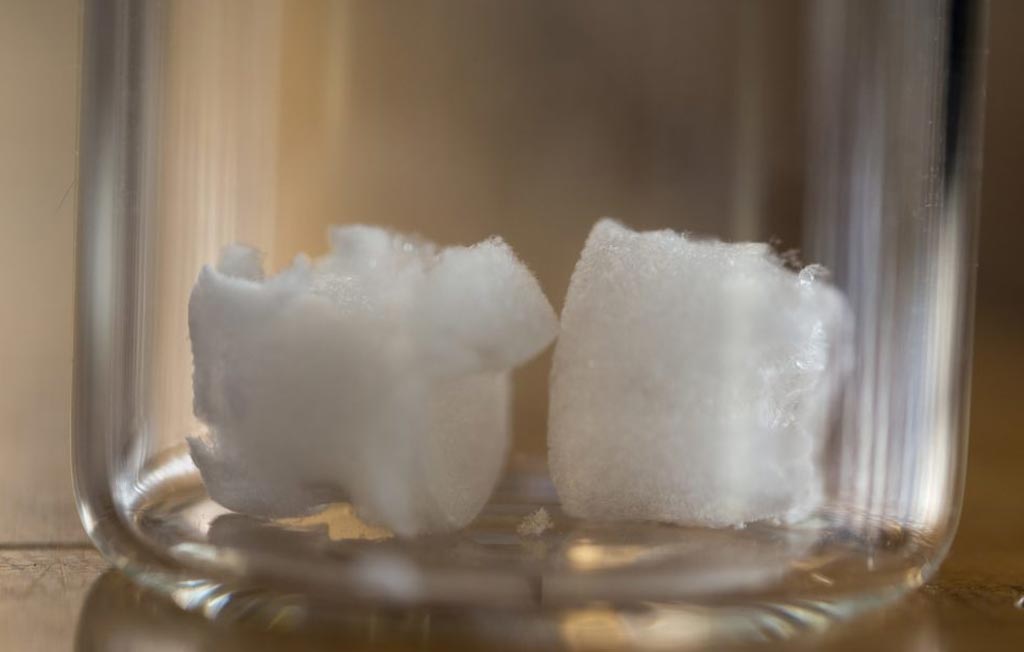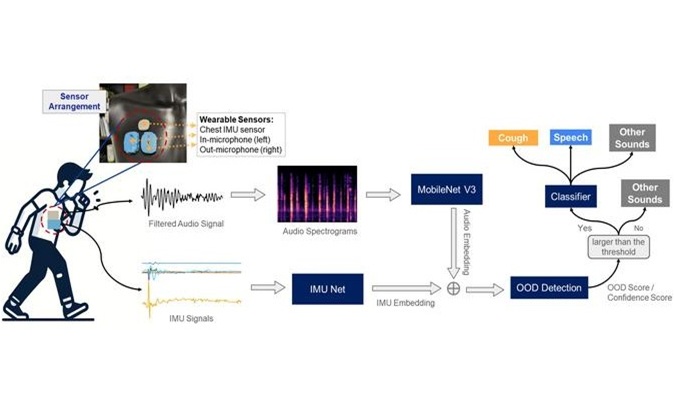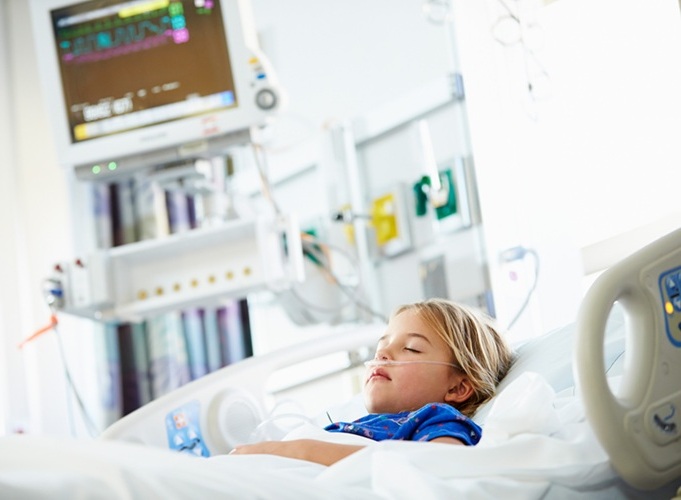Plant Cellulose Considered As Bone Implant Material
|
By HospiMedica International staff writers Posted on 03 Apr 2019 |

Image: A new study claims nanocrystals derived from plant cellulose can form a strong but lightweight aerogel (Photo courtesy of Clare Kiernan/ UBC).
A nanocrystal aerogel formed from plant cellulose could provide the scaffolding required for the growth of new bone, claims a new study.
Developed by researchers at the University of British Columbia (UBC; Vancouver, Canada) and McMaster University (Hamilton, ON, Canada), the biologic aerogel material is made from chemically cross-linked cellulose nanocrystals (CNC), and is designed to support osteoblast proliferation and enhance bone regeneration. The highly porous CNC aerogels also promote and support the growth of hydroxyapatite on their surface, as was demonstrated when submerged in simulated body fluid solutions.
In an in-vivo study of the CNC aerogels, which were implanted into the calvarian bone of adult male Long Evans rats, their osteconductive properties were demonstrated, and an increase in bone volume of up to 50% was shown, as compared to sham sites. And at 3- and 12-week time points, the CNC aerogels showed an increased bone volume fraction of 33% and 50%, respectively. The study was published on March 15, 2019, in Acta Biomaterialia.
“We can see this aerogel being used for a number of applications, including dental implants and spinal and joint replacement surgeries, and it will be economical because the raw material, the nanocellulose, is already being produced in commercial quantities,” said senior author biomedical engineer Professor Kathryn Grandfield, PhD, of McMaster University. “This summer, we will study the mechanisms between the bone and implant that lead to bone growth. We'll also look at how the implant degrades using advanced microscopes.”
“Most bone graft or implants are made of hard, brittle ceramic that doesn't always conform to the shape of the hole, and those gaps can lead to poor growth of the bone and implant failure,” said lead author Daniel Osorio, MSc, a PhD student in chemical engineering at McMaster University. “We created this cellulose nanocrystal aerogel as a more effective alternative to these synthetic materials.”
Cellulose is a homopolysaccharide of glucopyranose that can be either regenerated to form organized fibers or remain non-regenerated with unorganized fibers. Structurally, cellulose consists of crystalline and amorphous regions; by treating it with strong acid, the amorphous regions can be broken up to produce CNC. Cellulose is an important structural component of the primary cell wall of green plants, and is the most abundant organic polymer on Earth. The cellulose content of cotton fiber is 90%, and of wood 40–50%.
Related Links:
University of British Columbia
McMaster University
Developed by researchers at the University of British Columbia (UBC; Vancouver, Canada) and McMaster University (Hamilton, ON, Canada), the biologic aerogel material is made from chemically cross-linked cellulose nanocrystals (CNC), and is designed to support osteoblast proliferation and enhance bone regeneration. The highly porous CNC aerogels also promote and support the growth of hydroxyapatite on their surface, as was demonstrated when submerged in simulated body fluid solutions.
In an in-vivo study of the CNC aerogels, which were implanted into the calvarian bone of adult male Long Evans rats, their osteconductive properties were demonstrated, and an increase in bone volume of up to 50% was shown, as compared to sham sites. And at 3- and 12-week time points, the CNC aerogels showed an increased bone volume fraction of 33% and 50%, respectively. The study was published on March 15, 2019, in Acta Biomaterialia.
“We can see this aerogel being used for a number of applications, including dental implants and spinal and joint replacement surgeries, and it will be economical because the raw material, the nanocellulose, is already being produced in commercial quantities,” said senior author biomedical engineer Professor Kathryn Grandfield, PhD, of McMaster University. “This summer, we will study the mechanisms between the bone and implant that lead to bone growth. We'll also look at how the implant degrades using advanced microscopes.”
“Most bone graft or implants are made of hard, brittle ceramic that doesn't always conform to the shape of the hole, and those gaps can lead to poor growth of the bone and implant failure,” said lead author Daniel Osorio, MSc, a PhD student in chemical engineering at McMaster University. “We created this cellulose nanocrystal aerogel as a more effective alternative to these synthetic materials.”
Cellulose is a homopolysaccharide of glucopyranose that can be either regenerated to form organized fibers or remain non-regenerated with unorganized fibers. Structurally, cellulose consists of crystalline and amorphous regions; by treating it with strong acid, the amorphous regions can be broken up to produce CNC. Cellulose is an important structural component of the primary cell wall of green plants, and is the most abundant organic polymer on Earth. The cellulose content of cotton fiber is 90%, and of wood 40–50%.
Related Links:
University of British Columbia
McMaster University
Channels
Critical Care
view channel
Origami Robots to Deliver Medicine Less Invasively and More Effectively
Delivering medicine to ulcers or other internal sites often requires invasive procedures that can disrupt surrounding tissues and lengthen recovery times. Traditional magnetic actuators used in soft robotics... Read more
Improved Cough-Detection Technology Aids Health Monitoring
Coughing serves as an important biomarker for tracking a variety of conditions and can help monitor the progress of respiratory diseases or predict when someone’s asthma is being exacerbated.... Read moreSurgical Techniques
view channel
Novel Glue Prevents Complications After Breast Cancer Surgery
Seroma and prolonged lymphorrhea are among the most common complications following axillary lymphadenectomy in breast cancer patients. These postoperative issues can delay recovery and postpone the start... Read more
Breakthrough Brain Implant Enables Safer and More Precise Drug Delivery
Delivering medication directly to specific regions of the brain has long been a major challenge in treating neurological disorders. Current implants and infusion systems typically reach only one or two... Read morePatient Care
view channel
Revolutionary Automatic IV-Line Flushing Device to Enhance Infusion Care
More than 80% of in-hospital patients receive intravenous (IV) therapy. Every dose of IV medicine delivered in a small volume (<250 mL) infusion bag should be followed by subsequent flushing to ensure... Read more
VR Training Tool Combats Contamination of Portable Medical Equipment
Healthcare-associated infections (HAIs) impact one in every 31 patients, cause nearly 100,000 deaths each year, and cost USD 28.4 billion in direct medical expenses. Notably, up to 75% of these infections... Read more
Portable Biosensor Platform to Reduce Hospital-Acquired Infections
Approximately 4 million patients in the European Union acquire healthcare-associated infections (HAIs) or nosocomial infections each year, with around 37,000 deaths directly resulting from these infections,... Read moreFirst-Of-Its-Kind Portable Germicidal Light Technology Disinfects High-Touch Clinical Surfaces in Seconds
Reducing healthcare-acquired infections (HAIs) remains a pressing issue within global healthcare systems. In the United States alone, 1.7 million patients contract HAIs annually, leading to approximately... Read moreBusiness
view channel
Philips and Masimo Partner to Advance Patient Monitoring Measurement Technologies
Royal Philips (Amsterdam, Netherlands) and Masimo (Irvine, California, USA) have renewed their multi-year strategic collaboration, combining Philips’ expertise in patient monitoring with Masimo’s noninvasive... Read more
B. Braun Acquires Digital Microsurgery Company True Digital Surgery
The high-end microsurgery market in neurosurgery, spine, and ENT is undergoing a significant transformation. Traditional analog microscopes are giving way to digital exoscopes, which provide improved visualization,... Read more
CMEF 2025 to Promote Holistic and High-Quality Development of Medical and Health Industry
The 92nd China International Medical Equipment Fair (CMEF 2025) Autumn Exhibition is scheduled to be held from September 26 to 29 at the China Import and Export Fair Complex (Canton Fair Complex) in Guangzhou.... Read more














